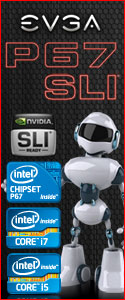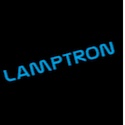As we begin our up close look at the EVGA Z77 FTW, we begin at the bottom area of the motherboard. Looking at the left side, we can see the secondary 6-Pin PCI-e power connector used for feeding additional power to the graphics cards. This PCI-e 6-Pin connector is labeled as secondary, and therefore only needs to be used under extreme overclocking environments. Also located in this area is the built in speaker, two USB 2.0 front panel headers, and the Firewire front panel header.
Moving over to the right side, we find the first two of seven fan headers on the board. The front panel USB 3.0 connection (ASMedia), the front panel switch/LED connections, and the triple BIOS switch are all located here as well. The triple BIOS switch is a welcome sight for a number of reasons; none more important than the ability to recover from a BIOS flash gone bad. All you have to do is throw the switch to another position and you will be able to boot the system again. Beyond the BIOS flashing, the ability to test out up to three different BIOS versions is something most enthusiasts will enjoy having.
Sitting right on the corner is the removal BIOS chip holder, which allows for replacing the BIOS chip should disaster strike and you manage to corrupt all three available BIOS positions.
 |
 |
 |
 |
The right side of the Z77 FTW has the eight right angled SATA ports at the bottom area. The four red ports are SATA 6 Gp/s, but only the lower two are native to the Z77 chipset. The top two SATA 6 Gp/s ports are provided by the Marvell 9182 controller as a third party solution. Just next to the SATA ports is a PCI-e disable DIP switch, which allows the user to disable any of the 5 slots. This can be a big time saver if you are trying to troubleshoot a video card problem when using multiple cards.
Moving upward we come to the right angled 24-Pin ATX power connector (great for cable management), the post code LED, and the onboard reset/power/clear CMOS buttons. In a break from tradition EVGA has moved the POST code LED and the onboard buttons from the bottom of the board to a location that is more accessible/viewable once the system is assembled. Sitting on the very top right corner is another fan header.
You may have noticed the jumper behind the black SATA ports, labeled “Dark Mode.” Setting this jumper to the enabled position will turn off all the onboard lighting, except for the post code LED.
 |
 |
 |
 |
The top area of the Z77 FTW gives us our first look at the four DDR3 DIMM slots, and a couple of the enthusiast features included on the motherboard. On the outside edge of the board is the new style voltage read out pins. You can use these to manually check the different voltages using a digital volt meter. Unfortunately, none of the pins are marked as to what pin is for what voltage. I was able to obtain the information from EVGA, and below is the pin out information from left to right. There are plans in place to offer a “Probelt” which will plug into the voltage read out socket, making it much easier to access the voltage readings.
VCORE-GND-DIMM-GND-VCPU_VCCIO-GND-PCH-GND-CPU_PLL-VSA
There are two more fan headers at the top of the board; one for the CPU and the other being labeled as a chassis fan. There are dual 8-Pin ATX CPU power connections located here as well, one of which has a sticker stating that it only needs to be used under extreme overclocking conditions. If your power supply has two 8-Pin power leads, then I recommend plugging them both in. More available power is a good thing and it certainly won’t hurt anything.
 |
 |
 |
 |
The four native USB 3.0 ports and six USB 2.0 ports are found on the left side of the motherboard’s I/O area. In addition to the ample USB connectivity, there are two E-SATA and two LAN ports at your disposal. EVGA has gone back in time and added a P/S2 keyboard connection for those of you that need one. Rounding out the I/O area is a clear CMOS button, the Realtek 8-channel analog jacks, the optical out port, and a display port connection.
The front panel audio connection, and the SPDIF connection are located at the bottom area of the motherboard’s left side. You can also see some of the many 100% solid state capacitors used on the Z77 FTW from this angle.
 |
 |
A look at the back side of the motherboard shows EVGA uses screws to attach the heatsinks. The screw down method provides superior contact with the target area when compared to spring loaded pushpins used by other manufactures. Past EVGA socket 1156/1155 motherboards have offered the ability to use an older socket 775 CPU cooler by multi-drilling the motherboard to accept both. There are only four CPU cooler mounting holes around the CPU socket, which unfortunately means support for socket 775 coolers has been eliminated from the Z77 FTW. This is probably not a big deal to the vast majority of users out there, and even if you have a socket 775 cooler that you just can’t part with, chances are there is an adapter kit available to make it work on socket 1155/1156 motherboards.

There are several third party solutions used on the Z77 FTW, but the main ones are ASMedia for the front panel USB 3.0, Marvell for the LAN/E-SATA/2xSATA 6Gp/s, Realtek for high definition audio, and VIA for Firewire.
 |
 |
 |
 |
 |
 |
 |
|
Moving toward the center of the motherboard, we can see the five available PCI-e graphics slots. Each location is marked with the corresponding slot number on the PCB. For those of you who are interested, here is the PCI-e lane configuration:
- 1 Card: x16
- 2 Cards: x16 – x16 (Slot 2 & Slot 4)
- 3 Cards: x8 – x16 – x16
- 4 Cards: x8 – x16 – x8 – x8
Just to the left of PCI-e slot #1 is the primary PCI-e 6-Pin power connection, which should be used with any multiple graphics card configuration.
One thing that struck me as I was looking at the CPU socket area is how uncluttered it is. It’s hard to imagine any CPU cooler that wont fit, given the openness of the area. Even the DIMM slots are positioned a good distance away from the CPU socket, making the use of memory with tall heatsinks possible. Do you notice anything different from the norm on the DIMM slots? Look closely and you will see that only the outer edge of the slots have the lock/release lever. EVGA has done away with a lever on both ends of the DIMM slots. When I installed the memory, it felt secure and locked in place as expected. As usual, EVGA has applied a sticker over the DIMM slots with recommended voltage and the proper population method.
 |
 |
 |
|
Next up is removal of the cooling solution provided on the Z77 FTW, and taking a look under the hood. First to be removed was the passive heatsink covering the PWM chips. The thermal pad was making good contact with all the target areas, albeit a little more so on the lower area.
 |
 |
The active cooling solution on the Z77 FTW serves a dual purpose. The heatsink covers, and provides the cooling for, both the Z77 PCH and the PLX PEX8747 chip. The PLX chip is used to provide PCI-e 3.0 capabilities spanning over the five available PCI-e slots. The active cooler uses thermal pads for both target areas, and was found to be making good contact with each chip.
 |
 |
 |
|

 Posted in
Posted in 





